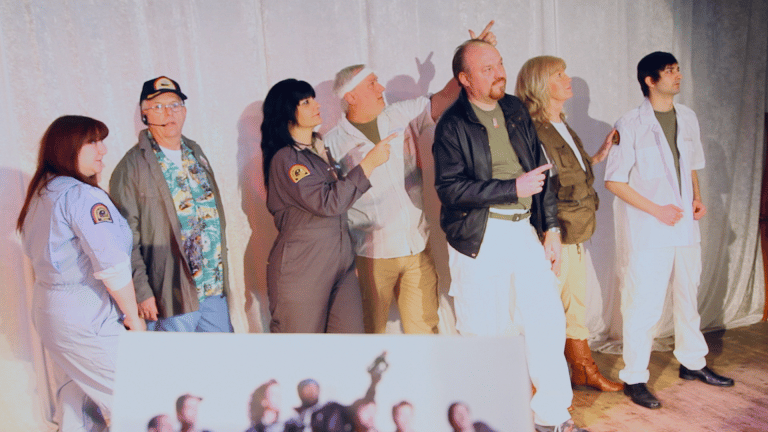Read also:
How to Watch FX Live Without CableHow To Watch AMC Without CableHow to Watch ABC Without CableHow to Watch Paramount Network Without CableThe immigrant experience, ad-man hagiographies, and scrappy homespun productions of Alien mark SXSW’s documentary spotlight.
(This dispatch is part of our coverage of the 2021 SXSW Film Festival.)
The final day of SXSW’s Documentary Spotlight section showcases movies about collaboration, creativity, and a hope and dream for achieving new heights. This slate featured a movie about a Latinx teenager working on a strawberry farm hoping to one day go to college and buy a house, a group of scientists pushing human achievements in space towards a new frontier, an ambitious and heralded graphic designer who believes his projects and field can help save the world, and a group of ragtag Englishmen who are inspired to put on a stage production of Ridley Scott’s Alien.
As we look to see the COVID-19 pandemic resolved and move on past these difficult times, the power of collaboration, camaraderie, and human connection is what will be our saving grace. We sign off on the Documentary Spotlight section with movies that embody just that.

Perhaps the most metaphorically-rich documentary of the Spotlight section thus far is Emily Cohen Ibáñez’s Fruits of Labor. Combining direct narration of personal history and experience as a minority in the United States with poetic introspection on life and humanity, we get to see the existence of a group of teens who work in strawberry fields in California and must perform the functions of adults even as they are still navigating through adolescence.
Ashley Solis, her mom and her siblings live in a shared space where ten families share a single bathroom. Her life, consisted of going to school and working long hard hours in the strawberry fields as the family’s main source of income, is certainly drastically different from most America kids, but she tries her hardest to live like a regular teenager.
Ibáñez uses brilliant shots of the strawberry fields and sunlit forests of California juxtaposed with the claustrophobic and unaccommodating conditions in Ashley is forced to live, to illustrate her struggles through the present to reach an eventual dream. She goes on walks with her boyfriend thinking of one day settling down in a house with a beautiful view.
Fruits of Labor has a conscious understanding of the different pressures facing immigrant Latinx communities in America that make advancement and progress difficult, from being part of the only industry (farming) that still uses child labor, to the constant threat of ICE crackdowns, and economic instability that stifles affordability of any recreational expenses. Even as the freedom of college approaches and the plants start to bear fruit in Ashley’s life, the roots of responsibility to her undocumented mother and her brother who now has a pregnant girlfriend, make for a bittersweet immediate future.

The future of individual lives and the future of the collective human race is a dilemma at the core of the documentary The Hunt for Planet B. While researchers and engineers and astronomers build giant space telescopes and fund major projects to try to detect other planets that are capable of sustaining life, some ask why not first try to preserve the life we have here? Lt. Col. William Anders of the Apollo 8 mission said, “We came to explore the Moon but what we discovered was Earth.” The Hunt for Planet B showcases scientists and enthusiasts who tussle with the insatiable desire to discover new frontiers with the internal fight to sustain and appreciate what exists right before our eyes.
Nathaniel Kahn’s approach is visually polished in its space, technology, and nature, all colliding to supplement the existential questions that form the overlap of all three. Yet, the interviews and questioning by the filmmakers remain a little awkward and repetitive, and the focus of the documentary wavers from time to time. While the documentary respectably understands the political and social elements associated with its astronomical subjects, its desire to be “of the current cultural moment” hurts its focus.
Giving some airtime to superfluous elements like an Alex Jones conspiracy theory rant playing on radio zaps the documentary of the singular power it pulls from people who are truly immersed and personally invested in the subject. As easy to watch as the documentary is, it doesn’t quite hit the depth of intrigue other ones like it, namely the Cosmos TV series or the brilliant Particle Fever (2013), do.

While documentaries that center on a ‘concept’ encounter the challenge of maintaining thematic focus, Mau, which centers on a singular person, revolutionary designer Bruce Mau, encounters a different problem – hagiography. It’s one thing to call renown to an influential and fascinating individual, both words describing Mau quite well, but it’s another thing to have ten different people fawn over his brilliance in repetitive cycles of pure idolatry.
There’s something to be said for pushing boundaries and bringing in new ideas. But there’s nothing in Benji and Jono Bergman‘s documentary that penetrates real-world problems beyond the hope and optimism – something Bruce Mau is self-proclaimed in – of symbolic and schematic thinking, despite reifying time and against that that is the whole point of his work.
The documentary builds a portrait of Mau as a rags-to-riches story meshed with hidden genius. He comes from the isolated Sudbury, Canada, which may as well be a frozen planet unto itself, and becomes a prodigy, dropping out of college and working his way with revolutionary ideas from the get-go.
But as the documentary goes on, there is so much pressure put on people’s words and decrees of his world-changing impact that it becomes head-scratching to see things like the Coca-Cola “Think Positively” campaign of “Guate Alama!” played in earnest. There’s no denying that Mau is successful and good at what he does, but for a documentary on his life and work, Mau seems so desperate to try to prove how and why he is great rather than have the confidence to let his career speak for itself.

Ridley Scott’s Alien is a movie that needs no explanation for why it’s famous or popular. From its intricate designs by famed art director H.R. Giger to its raucous score, brilliant thrills, and an amazing cast featuring Sigourney Weaver, Tom Skerrit, John Hurt, and the recently passed Yaphet Kotto, it’s a movie that has more than stood the test of time, its reputation has actually grown with the passing years.
In England, the movie was a strange choice for a theatrical production, usually reserved for more refined or light-hearted fare like The Adventures of Robin Hood. Yet, a ragtag group of novice actors, writers, crew, and director, many of who worked as bus-drivers or other blue-collar jobs, put together a performance of Alien which played at London’s famous West End.
Lucy Harvey and Danielle Kummer’s documentary Alien on Stage recounts the many rehearsals, obstacles, and raw nerves that went behind the successful production. It’s a documentary filled with a love of creation and collaboration that is infectious. You can tell the people working here are in love with what they are doing and the quality of the production, home-made props, costumes from scratch, everything micro-budget, is elevated through the level of deep connection they have with the material and the enjoyment they get out of putting on the show.
Alien on Stage showcases the transcendent power of art and culture to bring people together. It’s actually the best movie at SXSW about the pandemic (even though it was filmed before it) because it gears us up in anticipation to be able to do what was really missing this whole time – be with each other, and enjoy things together.

